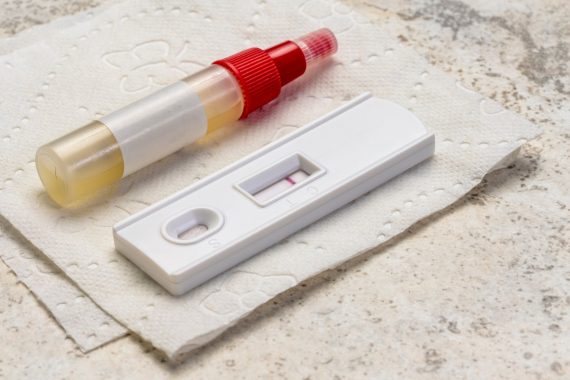GPs must conduct FIT tests for all ‘urgent’ referrals for suspected lower GI cancer, as part of a raft of priorities for the New Year, NHS England has said.
In new planning guidance for 2022/23, published on Christmas Eve, NHS England said a key priority for the year is to deliver ‘significantly more elective care’ to tackle the backlog.
It said: ‘Priority actions should centre on ensuring there is sufficient diagnostic and treatment capacity to meet recovering levels of demand, with a particular focus on the three cancers making up two-thirds of the national backlog (lower GI, prostate and skin).
‘This should include the] provision of sufficient commissioned capacity so that every urgent suspected lower GI cancer referral is accompanied by a faecal immunochemical test (FIT) result.’
The document also set an ‘ambitious’ target to ‘deliver around 30% more elective activity by 2024/25 than before the pandemic’ and ‘over 10% more’ than before the pandemic in 2022/23, despite ‘uncertainties’ caused by Covid.
This is ‘after accounting for the impact of an improved care offer through system transformation and specialist advice, including advice and guidance’ (A&G), it said.
NHS England also set a new target for GP use of A&G services, which involve GPs accessing specialist advice by telephone or IT platforms, rather than referring patients for a hospital investigation.
It said systems must deliver ‘16 specialist advice requests, including advice and guidance (A&G), per 100 outpatient first attendances by March 2023’, but it remains unclear how many of these requests should be GP A&G requests.
In October, GPs were told they must use A&G for 12 out of 100 outpatient attendances by March this year.
NHS England reiterated that systems must ‘eliminate’ wait of more than 104 weeks ‘as a priority’ and reduce 52-week waits ‘where possible’.
It added that they should ‘reduce’ waits of over 78 weeks, conducting ‘three-monthly reviews for this cohort of patients [and] extending the three-monthly reviews to patients waiting over 52 weeks from 1 July 2022’.
It remains unclear whether GPs will be required to conduct these reviews.
Meanwhile, NHS England also said that systems must improve ‘timely access to primary care’ by expanding capacity and increasing the number of appointments available.
It said: ‘Systems are asked to support the continued delivery of good quality access to general practice through increasing and optimising capacity, addressing variation and spreading good practice.’
Click to complete relevant cancer CPD modules on Pulse Learning.
Other priorities set out for 2022/23:
- Restore diagnosis, monitoring and management of hypertension, atrial fibrillation and high cholesterol and diabetes, as well as asthma and COPD registers and spirometry checks for adults and children, to pre-pandemic levels in 2022/23
- GPs to continue ‘catching up on the backlog of care for their registered patients who have ongoing conditions’ to prevent ‘avoidable hospital admissions’
- Increase the number of referrals to post-Covid services and proportion seen within six weeks
- Take ‘every opportunity’ to secure ‘universal participation’ in community pharmacist referral service, with the potential to move more than 15 million appointments out of general practice
- Increased NHS 111 capacity to make it ‘the credible first option for patients’
- GPs to promote use of the NHS App to patients’
- Expand the number of GPs ‘towards’ the 6,000 target
- Expand the use of staff banks, including the digital GP locum pool, and reduce ‘reliance on high-cost agency staff’
- HEE and NHSE to provide a ‘suite of national GP recruitment and retention initiatives to enable systems to support their PCNs to expand the GP workforce’
- Increase diagnostic activity to a minimum of 120% of pre-pandemic levels across 2022/23 and develop plans for further expansion of capacity through community diagnostic centres in 2023/24 and 2024/25
- Reduce outpatient follow-ups by a minimum of 25% against 2019/20 activity levels by March 2023 but ‘going further where possible’
- Create 5,000 additional urgent and emergency care beds, including by expanding virtual ward provision ‘towards a national ambition of 40–50 virtual wards per 100,000 population’ by December 2023
- Expand urgent treatment centre provision – ‘increasingly moving to a model where UTCs act as the front door of ED’
- Increase annual health check rates for people aged 14 and over on a GP learning disability register towards the 75% ambition in 2023/24, with each check accompanied by a ‘health action plan’ – and complete patient identification and coding on registers
- Improve uptake of lifestyle services, such as for diabetes prevention or weight management
- Delivery of Covid vaccine programme to remain a ‘key priority’
- Continued focus’ on the ‘health, wellbeing and safety’ of NHS staff
- Delay to ICS statutory arrangements taking effect from April 2022 to 1 July
The priorities and financial arrangements are ‘based on a scenario where Covid-19 returns to a low level’ and will ‘be kept under review’, NHS England said.
Source: NHS England














Sorry, what’s the point wasting money on a test that will NOT change management?
As a screening test, if FOB is positive, case needs referral, but if the GP ALREADY suspects GI cancer, then an urgent referral is mandatory with urgent asssessment, the priority for which would not be changed by either a positive FOB or a negative result !
Testing may even delay referral or proper management. (especially if someone decides that negatives get de-prioritised despite other markers of concern).
Your tariff = again £0.
Full Of Beurcracy.
Here’s a tip to most surgeries, as most you have overlooked it – most of your FiT bottles are out of date, and some of you are ordering FiT tests on rectal bleeding samples which is well, plain silly. Happy start to 22.
Bit early for April Fools
Got letters, very recently, from NHSE/I 98k among 6 CCG to increase FiT usage with 2WW but still must follow NG-12.
Just stop messing about, re-write NG-12 and problem solved. 9 months of messing about locally and still no clear solution/implementation
Basically FiT doesn’t equate with the cavalry coming over the hill to save Colorectal Service.
high risk fit straight to test is rationale I believe
We have been using FIT for a while
In combination with other signs and symptoms
2WW ref if FIT +ve
or Iron deficiency anaemia
or Weight loss
or abnormal abdominal or rectal examination
Other symptoms – routine referrals –
ongoing audit is happening
But I agree NICE 12 needs updating
It’s a bit confusing ! FIT is good for screening with high sensitivity and specificity.
But are our consultant colleagues going to prioritise colonoscopy and OP waits based on the FIT result? Are they going to reject the referral?
The sensitivity may be different in GP referral cohorts . Who’s responsible when a diagnosis is missed or delayed ?
If a test does not alter your management then don’t do the test. That is the mantra and is common sense.
Ask yourself if the clinical situation mandated a 2WW referral and the FIT came back negative would you not do the 2WW referral? Seriously?
NHSE is yet again setting targets that are not logical, waste money and could conceivably cause the late diagnosis for patients.
Im sorry P Cox, I have to disagree
FIIT is a poor test, upto 8-16% false negative rate! (published national audit figures)
Because the sensitivity varies depending on which area you live it and what level the lab sets its marker too?
It is a very brave consultant who downgrades it based on that, but we have all seen it happen.
I for one will be referring anyway, and will waste time and money doing a FIIT ‘while you wait’
What happens if bath door symptoms for two week wait but FIT negative? Referral returned? Where do we all stand medicolegslly!
Is this a cunning ploy to delay referrals several weeks whilst result awaited, and test likely needs repeating, and hence massage apparent waiting times?
Did anyone else spot the bit where they said it was “unclear” if GPs were going to expected to keep an eye on, and conduct reviews of the tens of thousands of patients waiting over a year for a hospital appointment?
WE REFERRED THEM TO SECONDARY CARE: IT IS THEIR PROBLEM NOW!
I guess we could update them when patients inevitably die while waiting to be seen in the big shiny building?